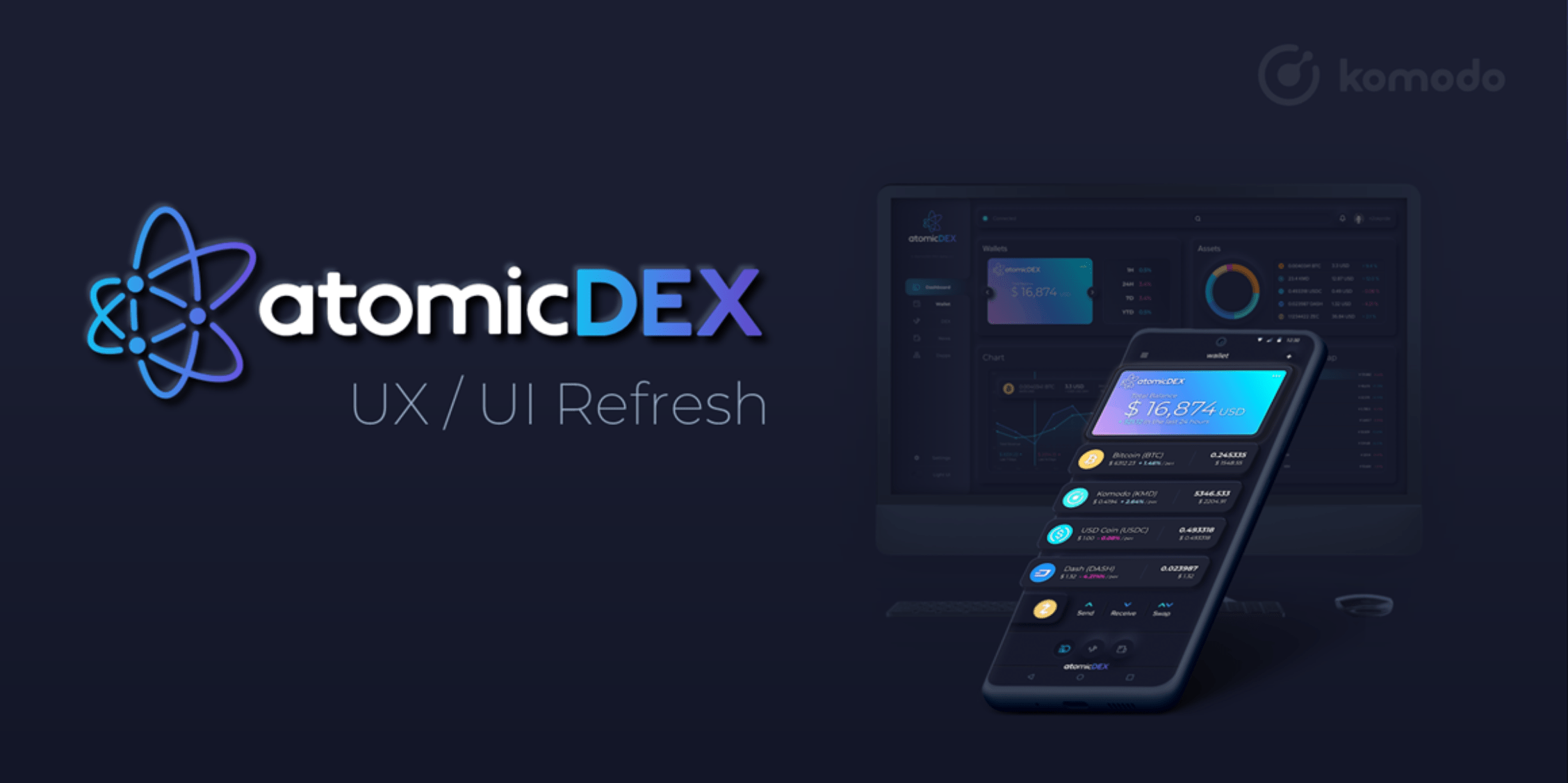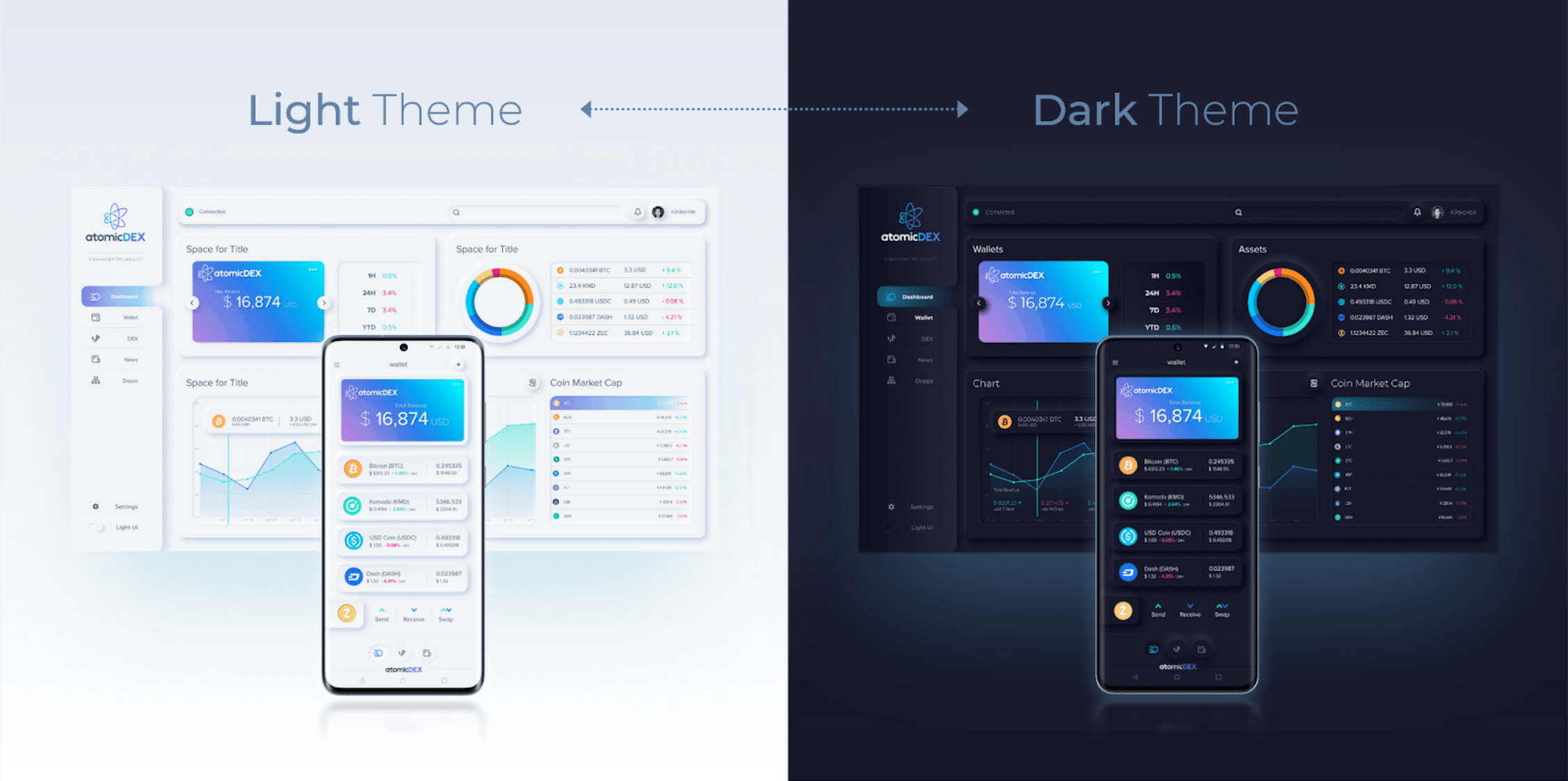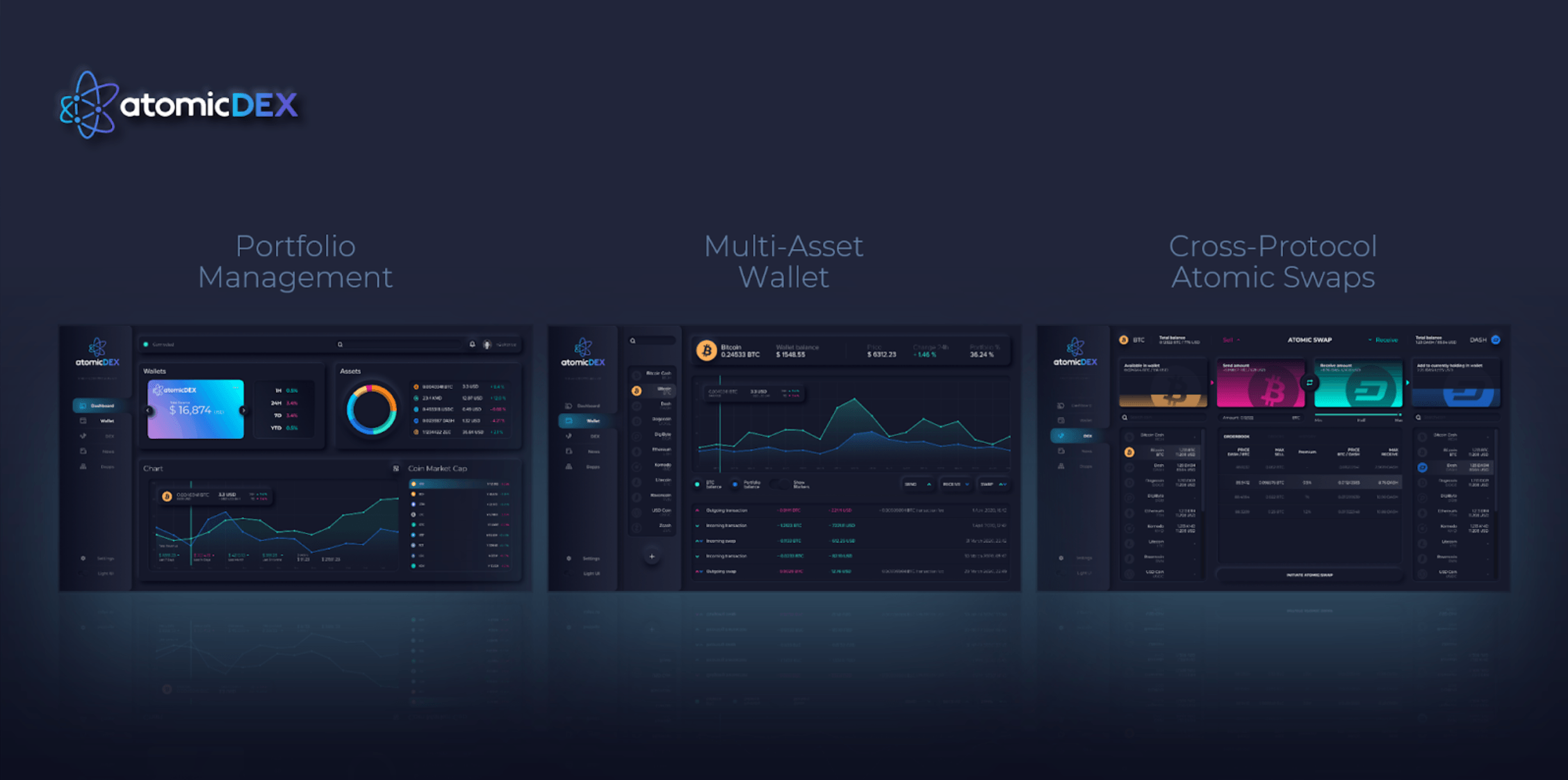2020 is proving to be a productive year for the growth of Komodo’s AtomicDEX cryptocurrency wallet and decentralized exchange hybrid.
Q1 and Q2 achievements include a complete reworking of the peer-to-peer backend framework, the first iteration of a reimagined graphical-user interface (GUI), and a friendlier UX. We are also excited to announce our updated roadmap for Q3 and Q4 as well as initial details around partnering opportunities for launch.

Advancing Atomic Swap Technology
Before we look at the latest updates for AtomicDEX, here’s a brief overview of the current landscape of atomic swap technology.
The vast majority of decentralized exchanges (DEXs) in existence today are only available through a single blockchain protocol. A large percentage of these DEXs only enable trading between ETH and ERC-20 tokens. Users who want to trade UTXO-based coins (e.g. Bitcoin) for account-based coins (e.g. Ethereum), or vice versa, have traditionally had to rely upon centralized exchanges (CEXs) or use “wrapped” proxy tokens, where trust in a third party is needed.
Our cross-chain and cross-protocol Atomic Swap technology enables traders to overcome the limitations of single-protocol or proxy-token and proxy-gateway DEXs. However, building a stable and scalable atomic swap platform has been one of the most challenging endeavors within the blockchain industry since this concept was first proposed in 2013.
Historical Overview Of AtomicDEX Development
Since Tier Nolan first proposed atomic swaps back in May 2013, Komodo developers have steadily worked to make this technology more practical for user adoption. Check out this article if you’re interested in learning more about Komodo and the early pioneers of atomic swaps.
Here’s a brief summary of our progress in developing atomic swap technology.
Generation 1: InstantDEX: a Proof-of-Concept for an atomic swaps-based decentralized exchange
In 2014, Komodo’s Lead Dev James ‘jl777’, along with Tier Nolan, developed the first generation of Komodo’s DEX technology built on the NXT blockchain network. This solution enabled cross-chain atomic swaps between NXT assets as well as between NXT and BTC. Like other atomic swap technologies developed at the time, this proof-of-concept was only useful for “dummy” swaps due to transaction malleability issues.
Generation 2: BarterDEX
BarterDEX launched in March 2017 as a solution for simple P2P swaps on desktop devices. It only supported UTXO-based networks at launch and later expanded support to account-based assets, including Ethereum and ERC-20 tokens, in February 2018. However, the networking layer of BarterDEX was not robust enough, and this sometimes resulted in failed swaps.
Generation 3: AtomicDEX
In July 2019, Komodo successfully launched the public beta of AtomicDEX, the industry’s first asset-agnostic mobile-native decentralized exchange built fully on atomic swaps. As of mid-July 2020, 130,764 atomic swaps have been successfully completed on AtomicDEX.
AtomicDEX currently supports the most blockchain protocols of any atomic swap solutions. New networks are continuously being added, enabling atomic swaps for protocol coins and their tokens. Popular assets listed include Ether (ETH) and ERC-20 tokens, Qtum (QTUM), Ravencoin (RVN), Zcash (ZEC), among others. We are very close to enabling Tezos (XTZ) swaps, and plan to add new protocols in the future.
In November 2019, we completed the first community-led stress test to assess the capabilities of AtomicDEX. This stress test provided a tremendous amount of valuable data that has enabled Komodo developers to focus their efforts on resolving potential bottlenecks in the networking layer. Throughout the first half of 2020, the project team has achieved several important milestones towards core improvement and expanding support across devices with the development of the AtomicDEX Mobile and AtomicDEX Pro applications.
Redesigned AtomicDEX Backend
Implementing a scalable and secure backend has been one of the most crucial tasks in the 2020 roadmap for AtomicDEX. Our ultimate goal is to build the infrastructure necessary for global mass-adoption.
A Brief Description Of The AtomicDEX Backend
We use various established and open-source technologies to operate the decentralized AtomicDEX peer-to-peer (P2P) network.
These technologies manage many of the common tasks of maintaining a decentralized peer-to-peer network. They include simple actions such as connecting to a network of users without relying on a single central hub, sending and receiving messages among thousands of decentralized users, and more.
P2P networking libraries have been around since the 1980s, and as they are commonly available, there is no need to develop a new one from scratch. The challenge is to choose and customize a solution that will meet the demands of real-time trading across multiple blockchain protocols.
A New P2P Library Under The Hood
Initially, AtomicDEX core was using different libraries for the networking layer, and they served us very well during the first few iterations and tests. However, based on the learnings of the first AtomicDEX core and network stress test in late 2019, we ultimately decided that an even more robust networking layer, capable of handling huge user numbers, was needed for the AtomicDEX core (API).
We have worked on tweaking the underlying architecture and refactoring the code base, which are necessary steps to sufficiently increase scalability. The new networking layer is capable of maintaining high-volume user networks and provides the exact specifications required for a DEX.
We are excited to push this new networking optimization to the limits during the next stress test. Sign up to our newsletter to make sure you don't miss it!
In addition to the improved networking layer, we also created interface filters for connection activation, which increases connection efficiency while preventing bottlenecks.
Designing A Secure GUI
In December 2019, some of our developers started focusing full-time on creating a new graphical user interface (GUI) for AtomicDEX Pro, the desktop version. We decided to implement it using Qt, a widely-acclaimed framework.
“Most software is inherently insecure, and this is especially true for anything related to blockchain and cryptocurrencies, simply because the industry is moving with warp speed,” said Kadan Stadelmann, Komodo’s CTO. “After evaluating multiple options, we decided to develop the AtomicDEX Pro GUI application with Qt, which is battle-tested, efficient, and known for utilization in critical sectors such as aviation, automotive, pharmaceutical, and energy industries.”
The Qt framework handles many common aspects of frontend application development, such as window management, displaying controls, and many other trivial development tasks. To build the AtomicDEX desktop GUI on Qt, our developers had to bridge the different layers to “connect the dots” between the AtomicDEX core (DEX backend, written in Rust) and the actual Qt GUI.
With the bridge in place, we started developing a QML-based frontend. Qt Markdown Language is similar to other common frontend languages such as CSS, but it is specifically designed to take advantage of the Qt library. QML allows developers to pull information from the backend, through the many connecting technologies, and into a beautiful frontend.
Our entire team is working at full speed towards the 1.0 release, which would come with a new visual design and also a more user-friendly interface.
Designing A UX For Mass Adoption
Blockchain technology can look intimidating to users, and to reach mainstream adoption, we need to simplify the experience.
We have completed thorough research of the current industry best practices, translated them to features, and designed a user interface that should satisfy both occasional users and true enthusiasts.
As the work continues, both AtomicDEX Mobile and AtomicDEX Pro will receive a complete facelift. Take a look at our interim designs yourself!



It is important to note that these are interim designs. We are true believers of collaboration and open development, and we regularly discuss the process with our core community. Join our Discord, and be part of the team developing the best UX in the industry!
A Revised Roadmap for Q3-Q4 2020
In June 2020, we surveyed 350+ respondents representing the core Komodo community, industry influencers, and traders. We gained valuable insights into what features they find the most important.
Based on their feedback, we will add new features to the app, including the delta of trades compared to centralized exchanges, candlestick charts, a slippage indicator, custom asset support, portfolio tracking, and more.
We will also make AtomicDEX compatible with at least one more large platform in the industry. In parallel with the development of new features, we will continue building and refining the new user interface.
Based on the learnings from the survey, we are revising and expanding our Q3-Q4 2020 roadmap.
AtomicDEX Mobile is on track to reach the final beta stage in late Q3, and we plan to release version 1.0 at the end of this year.
AtomicDEX Pro, our desktop version, is currently in public alpha and being tested by the core Komodo community. We are targeting to release a public beta in Q3, ahead of schedule. This is achievable by deprioritizing the OTC DEX product, which is now planned for early 2021.
AtomicDEX Web, the WebAssembly-powered self-contained DEX running in the browser, is in the research phase. We expect to make significant progress in late Q4 and release a public alpha next year.
Releases on all platforms will be preceded by two official stress tests: a simulated, automated network test in Q3 and a public test in Q4. Komodo supporters will be able to participate in the test towards the end of the year.
These tests will be conducted with the help of a community-powered market making product we are currently working on, together with a refactored API to connect third-party trading bots.
AtomicDEX Partnering Opportunities
AtomicDEX, the app, is just one reference implementation of the AtomicDEX API. We will also make our atomic swap technology available to developers, projects, and enterprise customers who seek to integrate atomic swaps into their own applications.
We are currently establishing use cases and exploring several possible avenues as part of our business development strategy to leverage existing technologies.
White Label Solutions - The AtomicDEX frontend applications for Desktop and Mobile, provide an end user interface to store and swap assets. AtomicDEX API, the backend software of AtomicDEX, enables trustless swaps, making it possible to set up and manage wallets for a variety of assets across multiple blockchain networks. Both of these solutions can be beneficial for projects that want a custom wallet or want to integrate a DEX into their dApps.
Native Bitcoin & UTXO Assets on All DEXes - The shared liquidity pool is an important feature of the AtomicDEX API that can be used by other decentralized exchanges built on a single blockchain protocol (e.g. ERC-20 DEXs). These exchanges could integrate with MM2 to tap into the liquidity of BTC, BCH, LTC, KMD, and a variety of other digital assets natively. While there are multiple efforts to make Bitcoin and other UTXO assets available on Ethereum DEXes and in DeFi applications, they all require a certain degree of trust in a third party. Atomic swaps make this integration possible in a completely trustless manner.
New Assets and Third-Party Integrations - AtomicDEX Mobile and AtomicDEX Pro might be "only" reference applications, but our aim is to make them as feature-complete as possible. Projects building on UTXO chains are welcome to add their assets to AtomicDEX, and we plan to integrate third-party services such as fiat gateways, gift card sellers, or instant exchanges as well.
Once the AtomicDEX API is completed, we will start taking partner applications for third-party integrations and white-labeling solutions.
Other possible use cases that require further research include the ability to support trustless trading of derivatives, synthetic assets, NFTs, tokenized real-world assets, and even to conduct Initial Atomic Swap Offerings. These are just a few of the many approaches we can take to drive the growth of the AtomicDEX ecosystem.
Stay Informed About The Latest Developments
The Komodo team will post regular updates to the community as their progress continues. Stay tuned for more details about the upcoming UX/UI update, feedback programs, product tests, and other news. Participants in community-wide events will have the chance to earn KMD rewards.
The best way to keep updated with everything connected to AtomicDEX is the Komodo Community Portal and the Komodo Discord Server.
We also started a separate Twitter account for AtomicDEX, where we regularly share development reports and community news.
